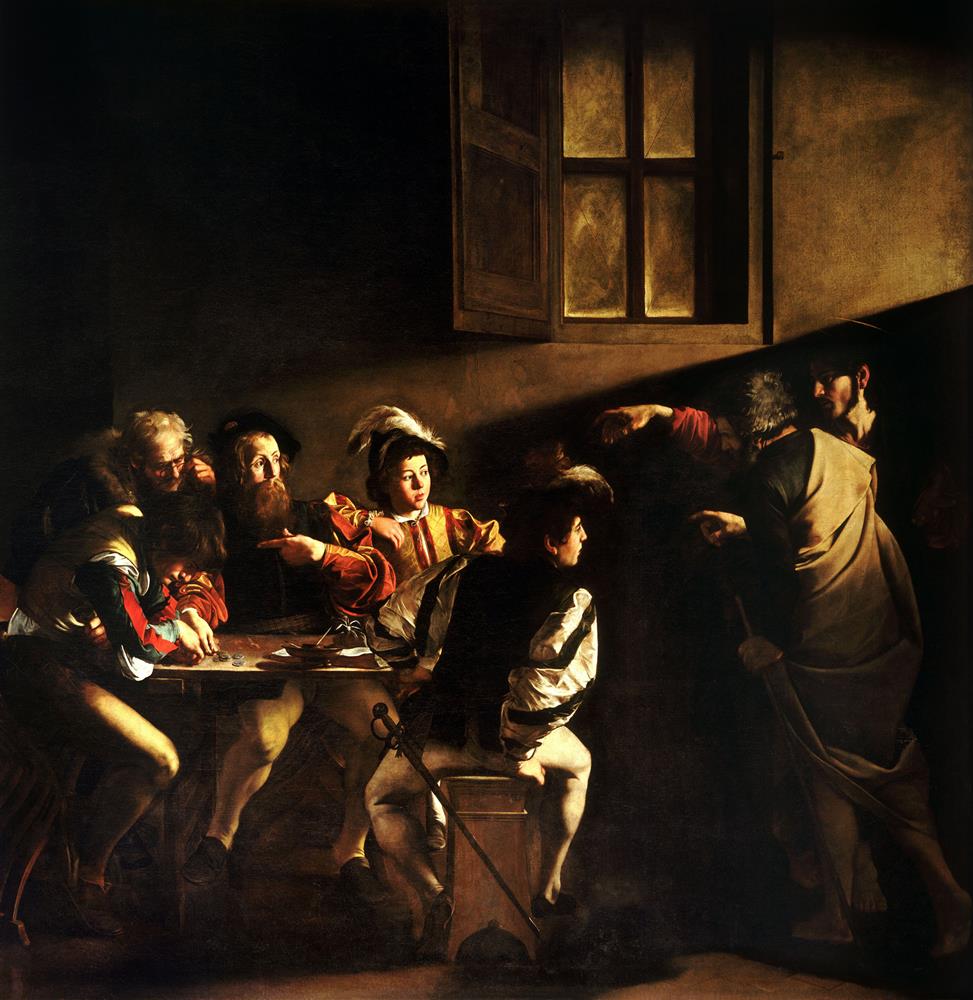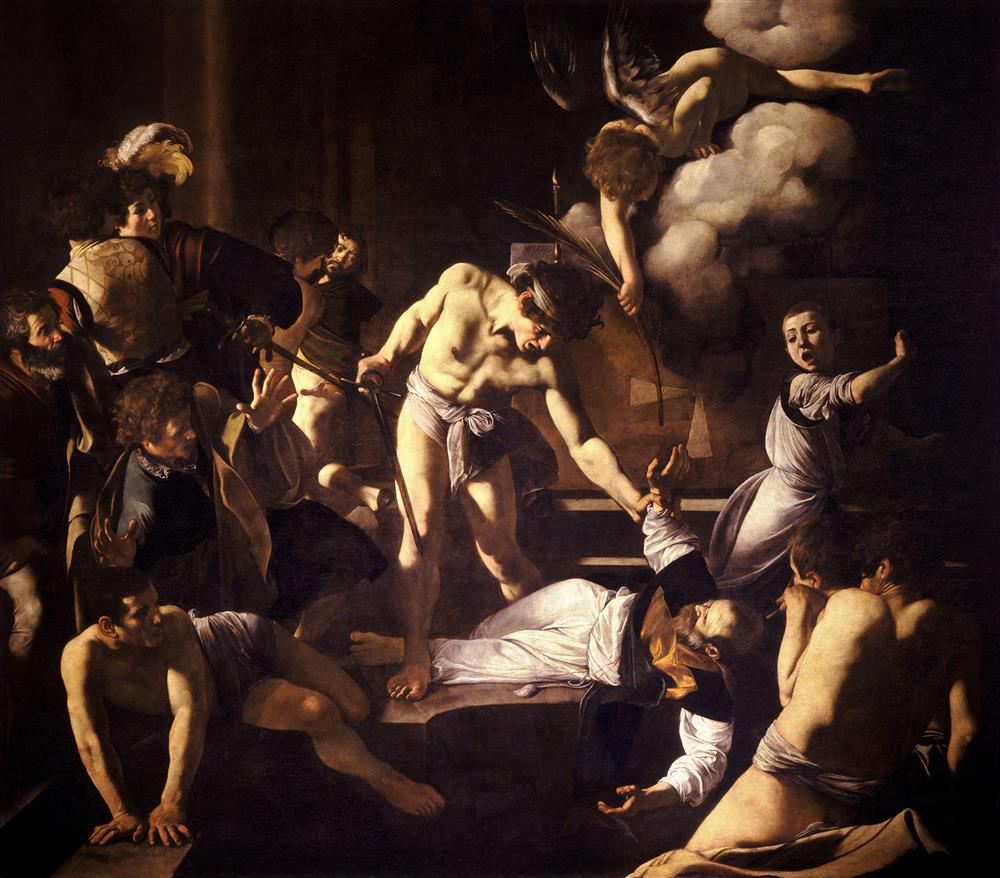Contarelli Chapel - Caravaggio
Matteo Contarelli built a chapel in 1565 for the church of San Luigi dei Francesi in Rome. The decoration of the chapel was not done until the death of Matteo Contarelli in 1585. For the altar in the chapel, a "Saint Matthew and the Angel" statue was considered. Flemish sculptor Jacob Cobaert was commissioned for this work. The side walls and vault frescoes would make Cavalier d'Arpino. D .Arpino finished the vault decorations between 1591-93. The walls in the chapel were still bare and unadorned.
For the chapel, in 1598, another artist was searched. In 1599, Caravaggio was interviewed. With the help of his patron, the Cardinal Maria del Monte, Caravaggio received the first important public order.
Caravaggio undertook the decoration of the Contarelli Chapel of the Church of San Luigi dei Francesi. He paints "The Martyrdom of Saint Matthew" and "The Calling of St Matthew" for the decoration of the Contarelli Chapel. Two years later, the altar board is ordered to replace Cobaert's statue for the Contarelli Chapel. The third order Caravaggio received is "Saint Matthew and the Angel”.
Saint Matthew and The Angel

Altar: In the painting "Saint Matthew and the Angel" by Caravaggio, the saint will be depicted in the writing of the Bible. In addition, Saint will be an angel of inspiration to prove that the revelations are the word of God.
Caravaggio designs Saint Matthew as an elderly, poor laborer, an ordinary folkman who has to write books in an impromptu moment. The old Matta savonarola sat in the chair and set to write the Gospel. In his description of Caravaggio, St. Matthew describes feet as a naked, dirty and bald person.Saint Matthew's had hands a thick book like a brick. He was anxious because of the writing act he was not familiar with. His uneasiness was reflected on his face. His forehead was wrinkled.In the table there is a young angel who gently directs the saint's hand. St. Matthew seems to be learning to read from an angels staring compassionately and solemnly. His forehead is wrinkled as he has difficulty reading. There is no halo on his head, which is an indication of Saint Matthew's saint.
The painting on display at the Kaiser Friedrich Museum in Berlin is devastated in World War II. Only black-and-white reproductions remain.
Caravaggio makes the second one shortly after the rejection of the first work. In his second work, Caravaggio described Saint Matthew as a white-beard and a double-layered red cape he wore on it. In contrast to his first description, Saint Matthew was standing with his left knee resting on his chair. The angel, depicted in the picture, hangs in the air with a white cloth covered by the light entering through the upper window of the chapel. The angel inspired the Bible to Saint Matthew. The apostle, which is an angel in his ear, transmits the text to the book with a pen created by Caravaggio's white brush touch.
Caravaggio has managed to block all criticism that has been rejected by a few master touches.Saint Matthew his left knee was standing on a stool that is toppling out of the painting. This detail added to the scene createsed a sense of reality in the viewer. Saint Matthew, depicted by Caravaggio, was a traditional saint with his gracefully handled pencil, glances to the angel on his head and a long beard. But the dissident painter Caravaggio maked his cunning again and describesed the feet of Saint Matthew as dirty.
The Calling of Saint Matthew

Left Wall: In "The Calling of St. Matthew", Caravaggio depicts the call of Jesus' tax clerk, St. Matthew, to the apostle. Saint Matthew, depicted in the picture, sits at a table. It shows itself in amazement and is busy with the taxes collected.
In the painting Caravaggio maked, in the background Jesus enter the scene from the right. The thin halo at the head of Jesus is lightly illuminated by Matthew's confused facial expression and a beam of light that illuminates Jesus' hand. The light beam be filtered through an opening and enters the space. The light comes from behind Jesus and falls on the full Matthew's. The other part of the picture is wrapped in gloomy shadows. In the picture, St. Peter is in front of Jesus, facing back to the viewer. St. Peter was described as old from Jesus and with a scepter in his hand.
In Caravaggio's drawing, Jesus is confronted with Matthew. In the description of this encounter, it is clearly seen that the feet of Jesus, standing in the semi-dark part of the Caravaggio painting, lead him out of the painting. As Jesus moved away from the collectivist, he turned towards him and pointed gently to call him. This gesture designed by Caravaggio for the figure of Jesus reminds us of God's hand movement that gave life to Adam in the frescoes of Michelangelo's Sistine Chapel.
Jesus' hand gesture excites the characters sitting around the table. A well-dressed surprised teenager nudges Matthew with his elbow. Caravaggio chose to capture a moment in which the tax officer lived before he could give a definitive answer when he understood the call. It is a moment of doubt, which lasts a few seconds, that Jesus' invitation is precisely directed at him. Cold air lacking emotion; The metal coins of the young debtor who paid his taxes with a sad face are reflected in his hand. With the intervening of Jesus, the mood of both Matthew and the instant atmosphere changed. Caravaggio portrays Matthew's conversion to a faithful loyalty to Jesus. Matthew is left in the middle of his new identity with collectivism. One arm still stretches towards the money and the other arm is put on the heart.
The Martyrdom of Saint Matthew

Right Wall: In his portrayal of "The Martyrdom of Saint Matthew," Caravaggio creates an atmosphere in harmony with the theme as well as practicing the traditional concept of illustration. He places a half-naked executioner figure on the center of the picture. The saint is at the foot of the feet of the executioner and lies parallel to the plane of painting. The child screaming from fear at the time of the murder is one of the most original elements of the scene.
The viewer, who follows the child's gaze, focuses on the main scene. The landscape at this center is so intense that the other figures remain behind. The angel who tried to keep the balance on a statue-like cloud stretched out his hand to the helpless Saint. In the left corner of the picture, two well-dressed young men, who wore their guns seem to be unaffected by the atmosphere. One of the two young people has a serious expression that can be considered almost satisfactory. He has placed his sword in his scabbard and is in a hurry to leave the stage.
In this overwhelming composition, the retreat of figures that hear the painful screams of St. Matthew is the most important feature of the painting. Caravaggio asked viewers to witness the suffering of Saint Matta in this gigantic-sized painting on the right wall inside the chapel.
The figure with a bearded face in the background mirrors the viewer's own reaction. It is as if the curiosity of the figure and the desire to be part of the event. But his face, wrinkled with concern, is trying to move away from the murder environment. He disguised himself as a desperate spectator against the scene of the martyr's inner shattering death. He is actually an eyewitness to this scene. This figure is Caravaggio himself.
In the table, dark and very bright sections were processed adjacent to each other, and the figures were made to look like embossed. In addition to this technique, it is desired to give the real truth with the most cruel and crude form.
As a result of the radiographic analysis on the picture, he revealed that under this picture, another picture that the artist covered was hidden. In this concealed version stands a soldier facing the back holding a knife in his hand on a monumental architectural background. This soldier attacked St. Matthew with his friend with his helmet in his head and sword in his hand. n the picture, Matthew is in the second plan. Caravaggio gave up the of the middle character in this last picture, and all the characters were pushed out of the frame and brought the injured Saint Matta to the fore. Also characters are placed completely different. Taking into account the environment in which the artwork will be placed, it has rearranged the dimensions of the figures.
Illuminating light falling on the characters; in fact, it follows the path of light coming from the window above the altar of the chapel in a masterful game between the real situation and the artificially created. Caravaggio went to San Luigi dei Francesi, studied the direction of natural light and applied it in his painting. The other two canvases in which the light changes according to where the tables are located illuminate in the same way. The most interesting aspect of these three tables is that the scenes in a darkness that are very close to the reality are enlightened by a suddenly falling light beam, so that the most dramatic moments of the event take place in memory.
Caravaggio, "Saint Matthew and the Angel", "The Martyrdom of Saint Matthew" and "The Calling of St. Matthew" in three of the traditional molds were removed. He created a dramatic realism loaded with silent social views. Writing the Bible with the inspiration of angel in his depictions, Jesus invites a tax collector to join him, strong themes such as the martyrdom of a saint; they were transformed into daily events in ordinary places. This attitude of the painter is not easily accepted by the administrators.
Caravaggio also significantly changes the concept of chapel decoration. The use of traditional frescoes was replaced by large canvases: sacred personalities are represented as living characters, and the religious significance of a tragic scene is effectively emphasized by the wise use of light. The reactions to the work are not generally positive but do not prevent the glowing of Caravaggio's star. The Contarelli Chapel will mark Caravaggio's journey to a striking career that will allow him to achieve a series of remarkable achievements in a few years' time. Young painters will admire him and compete to imitate him. Those who will be called Caravagogist will have an active role in spreading his style throughout Europe.
Bibliography;
Tükel, U. ve Arsal, S.Y., (2014). Sözden İmgeye Batı Sanatında İkonografi, Birinci Baskı, Kabalcı Yayıncılık, İstanbul.
Çev: Özbek, Ö., (2002). ArtbookCaravaggio Işık ve Gölgenin Yaratıcısı, Dost Kitabevi, Ankara.
D’Orazio, C., (2015). Caravaggio’nun Sırrı: Sanatın Gücü, İkinci Baskı, Dedalus Kitap, İstanbul.
Howard, A., (2017). İşte Caravaggio, Birinci Baskı, Hep Kitap, İstanbul.
Erdoğan, C.E., (2015). Sanatın Büyük Ustaları Caravaggio, Birinci Baskı, Hayalperest Yayınevi, İstanbul.
Lunday, E., (2013). Büyük Sanatçıların Gizli Hayatları, Beşinci Baskı, Domingo Yayınevi, İstanbul.
Aria, Ü.Ö., (2018). Caravaggio Dönemi-Yaşamı-Eserleri, Birinci Baskı, Hiperlink Yayınları, İstanbul.












